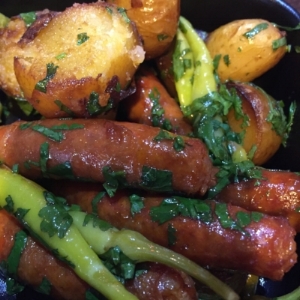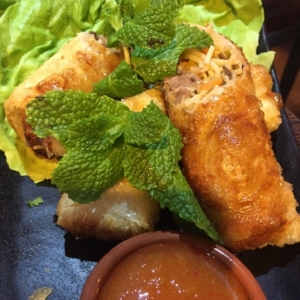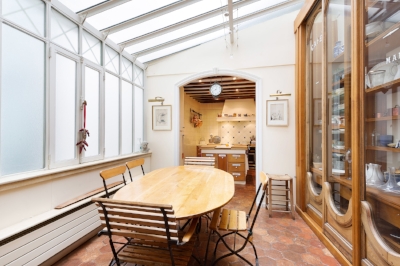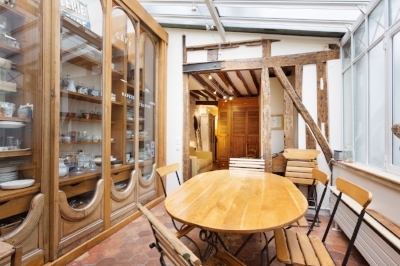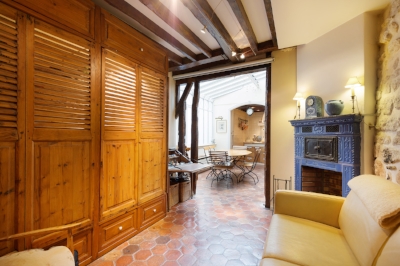A fulgurance is like a lightening bolt – a moment that is intense in emotion, unique, exceptional, mystical, and cannot be reproduced. These are the words of the Parisian restaurateur Rebecca Asthalter, who, along with partners Hugo Hivernat and Sophie Coribert opened Fulgurances l’Adresse on October 14th of this year. The concept is a new one: The restaurant will change chefs every six months, working with sous-chefs from well-known restaurants who are eager to go it on their own.
Their first featured chef, Chloé Charles, worked most recently as a sous-chef at the nearby Septime, under the tutelage of Bertrand Grébaut, and earlier she passed through the kitchens of l’Astrance with Pascal Barbot and David Toutain during his days at L’Agapé Substance. The restaurant – a casual, modern, clean little 36-seat spot in the city’s 11th arrondissement – is not far from the scene of the city’s horrors of November 13th. On that Friday evening police came to the restaurant, directing the owners to lock the doors, turn off the lights, and wait. By 1 am the police returned, allowing guests and the owners to vacate. Obviously, a rather challenging beginning to an already brave adventure. Parisians have shown themselves in the wake of these events to be extremely resilient, and restaurant was close to full on the two occasions that we visited the restaurant in the last two weeks.
Locals, as well as diners who had already experienced the trio's pop-up restaurants at various venues around Paris since 2010, have become loyal supporters, and on a recent evening the small, elegantly casual restaurant was overflowing with tables full of 30-somethings sharing Chloé Charles's inventive cuisine. Her food is modern, vibrant and forward flavored, ranging from a sumptuous starter of giant artichokes bathed in a touch of red wine, bone marrow and a hit of Roquefort, to an unusual and soothing salad of smoked eel, paired with a broccoli puree seasoned with a bright touch of mint and orange.
A main-course of plump, moist farm guinea hen was stuffed with herbs beneath the skin, seasoned with a yogurt sauce that included pepper, pear, and bit of grilled bread, a very modern bistro dish if there ever was one.
She boldly pairs squid and sweetbreads with a mixture of winter vegetables, meat juices and a bit of lemon, and offers a super-fresh portion of rouget barbet (red mullet), served with generous portions of pleurotte and chanterelle mushrooms as well as crisp chestnut chips.
One of the best tastes of the evening was her very bright flavored appetizer of mulet rillettes, served with the crusty sourdough bread from baker Olivier Haustraete of Boulangerie Bio near the marché d’Aligre. When baking the bread, the floor of the oven is spread with ground olive pits, which smoke as the bread bakes, giving each loaf a unique, smokey flavor.
The brief wine list offers some appealing selections, including Domaine Valette’s satiny, mineral-rich Maçon Chaintré.
Desserts were far less convincing, with a very dry poached pear with touches of quince mousseline, and a rather unimpressive chocolate cream dotted with bits of chocolate sablé.
The lunchtime menu is more low key, offering two choices for starters and mains, a cheese course and one dessert. The thick textured mushroom soup was adorned with the flavors of autumn: paper thin slices of pair, crumbled tangy Roquefort, onions and chestnuts. The pork braised in white wine was impossibly tender, served with simple garlic potatoes, shitake mushrooms and topped with a handful of arugula and fresh herbs that were a welcome refreshing touch. The 19€ 2-course / 22€ 3-course lunchtime menu is a fantastic bargain, even if the dessert did not inspire.
I’m eager to go back again, to watch the bustle of the open kitchen, see the restaurant progress, and share in the creation of this unique, brave, bold idea. Chloe Charles will be resident chef until May 2016.
Fulgurances l'Adresse | 10 rue Alexandre Dumas | Paris | +33 9 81 09 33 32 | Metro: Rue des Boulets | Open Wednesday through Saturday | 19 / 22€ lunch menus, 44€ dinner menu |
For more Paris restaurant reviews, get The Food Lover's Guide to Paris 5th edition, or download the app!




